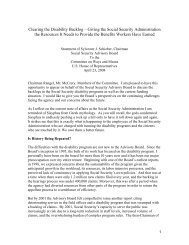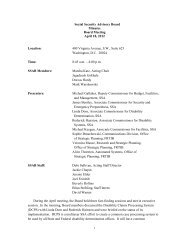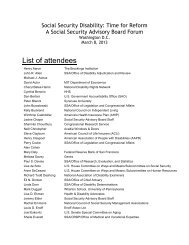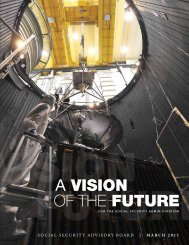Aspects of Disability Decision Making: Data and Materials
Aspects of Disability Decision Making: Data and Materials
Aspects of Disability Decision Making: Data and Materials
Create successful ePaper yourself
Turn your PDF publications into a flip-book with our unique Google optimized e-Paper software.
claimants or their appointed representative mustfile the appeal request in writing within 60 daysfrom the date the notice <strong>of</strong> unfavorable decisionis received. If the claimant does not take the nextstep within the stated time period, he or she losesthe right to further administrative review <strong>and</strong> theright to judicial review <strong>of</strong> this particular claim,unless good cause can be shown for failure to makea timely request.ReconsiderationGenerally, the reconsideration is the first level<strong>of</strong> appeal <strong>and</strong> consists <strong>of</strong> a DDS case review. It issimilar to the initial determination process exceptthat it is assigned to a different disability examiner<strong>and</strong> physician/psychologist team. Claimantsare given the opportunity to present additionalevidence to supplement the information that wassubmitted when the original decision was made.If the reconsideration team concurs with theinitial denial <strong>of</strong> benefits, the individual may thenrequest a hearing before an ALJ in the Office<strong>Disability</strong> Adjudication <strong>and</strong> Review.Administrative Law Judge HearingAdministrative law judges (ALJs) are based inthe 169 hearing <strong>of</strong>fices (including seven satellite<strong>of</strong>fices) located throughout the nation. At the hearing,claimants <strong>and</strong> their representatives may appearin person (or by videoconference), submit new evidence,examine the evidence used in making thedetermination under appeal, <strong>and</strong> present <strong>and</strong> questionwitnesses. The ALJ may request medical <strong>and</strong>vocational experts to testify at the hearing <strong>and</strong> mayrequire the claimant to undergo a consultative medicalexamination. The ALJ issues a decision based onthe hearing record <strong>and</strong>, in cases where the claimantwaives the right to appear at the hearing, the ALJmakes a decision based on the evidence that is in thefile <strong>and</strong> any new evidence that has been submittedfor consideration.DDSs <strong>and</strong> ALJs approach the decision makingprocess differently. DDSs conduct a paper review <strong>of</strong>a claimant’s medical <strong>and</strong> vocational evidence, whileALJs hold face-to-face hearings <strong>and</strong> have the opportunityto observe the claimants firsth<strong>and</strong>. Due tothe passage <strong>of</strong> time between the two decisions, ALJs<strong>of</strong>ten receive information that was not available tothe DDS <strong>and</strong> was not considered in that determination.In addition, hearings are more likely to involvepr<strong>of</strong>essional representation. Another difference isthe instructional basis for the decision; DDS adjudicatorsuse instructions found in SSA’s ProgramOperations Manual System (POMS) while ALJs relydirectly on the law <strong>and</strong> regulations. SSA is currentlyworking on an electronic case analysis tool thatwill bridge the two determination st<strong>and</strong>ards <strong>and</strong>improve both the quality <strong>and</strong> consistency <strong>of</strong> decisionsat all levels. Many experts contend that theseare some <strong>of</strong> the differences in the decision makingprocess that contribute to the high number <strong>of</strong> DDSdecisions that are reversed at the hearing level.Appeals Council ReviewSSA’s final administrative appeals step is tothe Appeals Council. If the claimant is dissatisfiedwith the hearing decision, he or she may requestthat the Appeals Council review the case. TheCouncil, made up <strong>of</strong> administrative appeals judges,may also, on its own motion, review a decisionwithin 60 days <strong>of</strong> the ALJ’s decision.The Appeals Council considers the evidence <strong>of</strong>record, any allowable additional evidence submittedby the claimant, <strong>and</strong> the ALJ’s findings <strong>and</strong>conclusions. The Council may grant, deny, or dismissa request for review. If it agrees to review thecase, the Council may uphold, modify, or reversethe ALJ’s action, or it may rem<strong>and</strong> it to the ALJso that he or she may hold another hearing <strong>and</strong>issue a new decision. The Appeals Council mayalso rem<strong>and</strong> a case in which additional evidence isneeded or additional action by the ALJ is required.The Appeals Council’s decision, or the decision<strong>of</strong> the ALJ if the request for Appeals Councilreview is denied, is binding unless the claimantfiles an action in a Federal District Court.Judicial AppealsFederal District CourtClaimants may file an action in a Federal DistrictCourt within 60 days after the date they receivenotice <strong>of</strong> the Appeals Council’s action. In fiscalyear 2010, 13,229 new Social Security cases wereappealed to the district courts, representing lessthan 5 percent <strong>of</strong> the district court civil caseload.Circuit Court <strong>of</strong> Appeals <strong>and</strong> Supreme CourtIf the U.S. District Court reviews the caserecord <strong>and</strong> does not find in favor <strong>of</strong> the claimant,the claimant can continue with the legal appealsprocess to the U.S. Circuit Court <strong>of</strong> Appeals <strong>and</strong>ultimately to the Supreme Court <strong>of</strong> the UnitedStates. The Social Security Administration may,similarly, appeal district or circuit court decisionsthat are favorable to the claimant.88 <strong>Aspects</strong> <strong>of</strong> <strong>Disability</strong> <strong>Decision</strong> <strong>Making</strong>: <strong>Data</strong> <strong>and</strong> <strong>Materials</strong>









